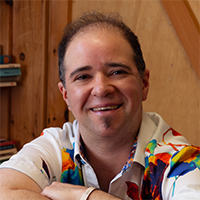Industry Interview: Talking Book Structure with Jendi Reiter, Editor of Winning Writers and Author of Origin Story
In this industry interview, I discuss book structure with Jendi Reiter, editor of Winning Writers, North Street Book Prize judge, and author of Origin Story, a literary novel about a gay man who recovers his traumatic memories by writing a superhero comic book in the 1990s.
I ask Jendi, what makes good book structure? What kinds of book structure do they typically notice in the North Street Book Prize, both effective and not-so-effective? How can self-publishers improve their book covers? How has Jendi's book structure been influenced by their North Street reading, and what words of advice do they have for North Street entrants?
Watch the entire interview on YouTube for all of Jendi's insights. Some highlights include:
Jendi on common difficulties with memoir structure (2:30):
It seems like we get a lot of memoirs that just go straight chronologically. You know, this is my childhood, this is my adulthood. And it takes a lot to make that retain interest… What I really like in a memoir, if it is going to be more straightforward/chronological, is to have a shorter span of time. You might start with a dramatic incident and then lead up to how you got there. Like, "I was at my father's funeral, and I did not expect him to die at forty-two. And I look back at what led to that". Then you go back. So you know what the payoff is going to be and why we are investing in this person's life story.
On poetry collection structure (4:48):
I feel like people don't structure their collections, and they should. I often get a batch of poems from someone, and maybe they're all good, but does one lead to the other? Poetry, I think, has to either have a narrative arc or a thematic weaving of two, or three, four, or five, themes and image sets that you're going to start with and develop. Like a fugue, like a motif that is being developed and recurring, intertwining with other, with other motifs. And to me, that's a collection that's really been thought through.
On art book structure (6:03):
With art books, there can be so many repetitive images, or images that don't seem to be presented in any particular order, and they might be really good images, but it becomes boring to read a whole book of it, where you don't really feel like it's building to anything. There has to be a sense that this is developed, it isn't just a collection.
On children's picture book structure (8:12):
With a picture book, sometimes people just try to put too many twists into a 32-page book, you know, or they make it much longer than a 32-page book, which for a picture book is, you know, a risky choice. So, you know, focus on one issue, one problem that's age appropriate, and then have the narrative resolve that problem.
On fostering a sense of unity in a book's structure (11:33):
[While writing, I've sometimes wondered], does this all make sense? Like, does this all belong in the same book, just because it belongs in my head? I think after a while, with a lot of practice, one can really lean into one's particular grab bag of weirdnesses and realize that you're the unifying factor. And if you're obsessed with certain things, somehow there's something they have in common, but you still have to find a way to sell that to the reader. And a lot of that has to do with just not lingering too long on things that don't serve the main reveal of the plot.
On using multiple genres to portray trauma recovery in Origin Story (26:37):
Trauma recovery is a lifelong process, and it's one that takes different forms the further you go along, but at different levels, hopefully higher levels, the more you go into that basement, and, you know, either slay the monster, or at least get rid of the monster, or make peace with the monster… Writing this book, and writing Peter's comic book scripts, where this character of the Poison Cure is either killing or curing people through his sexual contact, Peter's expressing the contamination that one feels as a sexual abuse survivor without knowing why. So his metaphors are telling him the truth before he knows the truth literally, and writing those scenes was so cool, to write a comic book script. I'm now working on a fantasy novel, which is very hard, and I learned a lot from trying out different genres within Origin Story.
On book cover design (34:24):
When I look at the book entries, often a couple of mistakes that people make with cover design is the cover doesn't fit the mood of the book, the cover is hard to read. I've seen books that had no title or author name anywhere on the book. Don't do that!
Contemporary book covers, unless they're biographies or history books, rarely have actual photos on them anymore. If you're using a stock photo on a book cover, it looks self-published in a way that isn't really to your advantage. A nice matte book cover with a good illustration will usually do you better for a literary book… Some of the memoirs have nice photo covers, but they have a kind of a sepia tone, or they've been manipulated in some way, where they look a little bit more soft focus, or they're inset with some other design elements… Readability is another issue. You want your design elements not to clash with your text elements. Both of those should be easy to read.
(For more insights about book cover design, see my conversation with our North Street co-sponsor and book design expert, Laura Duffy.)
On the importance of sensitivity readers (48:32):
In the literary world, there's a lot of over-sensitivity and weird, kind of ideological policing and asking for proofs of identity, which I think can be really unhelpful, but I think sensitivity reads as a practice are great. And if you want to call it something else, because sensitivity sounds like a weird word to you, that's fine, but just consider it research… If you were going to write an action movie, you'd research guns and airplanes and history and whatever it is. If you're going to write a medical thriller, you talk to a doctor about whether this is a plausible treatment for this illness, and are these the right symptoms. So if you're going to write about a certain culture or demographic, don't take it personally, as though you have to get permission from a group to write about a certain kind of character. Just think of it as, you want your book to be realistic and believable.
And a message of appreciation for North Street writers and poets (50:09):
Thank you for engaging with Winning Writers. We're really proud of you for having written a book, finished a book, designed a book, published a book, and had the guts to send it in to us! If we don't like it, somebody will. Just love yourself and write your books.
Learn more about our North Street Book Prize here: winningwriters.com/north
People, resources, and North Street winners mentioned in the video:
Ellen LaFleche, co-judge of the North Street Book Prize
Tracy Koretsky, poet and literary critiquer
Denne Michele Norris, writer and editor of Electric Lit
Critique Corner poetry critiques from Jendi Reiter and Tracy Koretsky
The Editors of Color Diversity Databases, for sensitivity reads, developmental editing, and more
Two Natures by Jendi Reiter
An Incomplete List of My Wishes by Jendi Reiter
Her Widow by Joan Alden
The Art of Symeon Shimin by Tonia Shimin
My Pants by Nicole Kohr
The Cricket Cries, the Year Changes by Cynthia Harris-Allen
Waking the Bones by Elizabeth Kirschner
Endemic by Robert Chazz Chute
Source: https://youtu.be/vv-dmAmLkNg?si=Jm4U7nzWo6DZ62ji
Categories: Advice for Writers, Annie in the Middle







